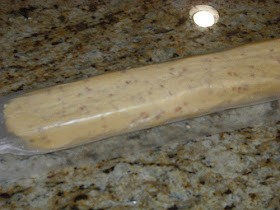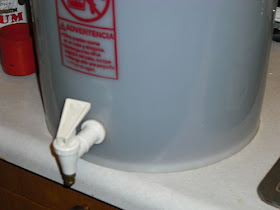Time to crack open a much awaited home brew. Yep, 15 days after bottling it's time to finally take a taste.
So here is a bottle.
and here is a glass.....
And here is the traditional way of drinking it in the "hefe" style (with yeast) by rolling the bottle on the counter (or bar) to mix it all up.
Then you make a long pour into a glass and admire the beige head...
None of that white foam on this my friends, for this is the the darker side of weizen...
Once it subsides a little, top off the glass.
Tip it back and enjoy.....
I was a little disappointed at how fast the head subsided though, I must not have gotten enough protein in the mash to stabilize the head... Not that there should be so much as to interfere with drinking, but it should be a little more stable than it was.... Also, I was hoping it would be a little darker. I was fooled by how dark the malt extract was, but I was thrilled with the "hit" of elderberry flavor.... it definitely had the "twang" I was expecting.... Unlike blonde "hefeweizen" there is NO lemon needed on this one... ;)
The recipe is below, in all it's glory, as I originally wrote it... though I have fleshed out the directions a little bit... I originally used a Brewer's Friend Template which is really a collection of labeled tables. You can give it a shot, if you would like, but I am going to make a couple alterations and give it another shot... But first, I think a little more "tasting" is in order, to ensure my alterations are in the best interest of this brew.
Yep, this is some SERIOUS research... LOL
I'll Be a Monkey's Dunkel
ElderWeizen (Dunkel)
8 oz Munich Malt
8 oz Wheat Malt
7 lbs 50/50 Barley and Wheat Malt Extract
1 oz Liberty Hops AA rating 5.2 - 60 minute boil (bittering)
1/2 oz Saaz Hops AA rating 5.1 - 15 minute boil (flavor)
Additions:
1 1/2 cups Elderberry Juice
Yeast - White Labs - WLP 300 (German Weizen Yeast) pitch @ 75 degrees
OG 1.059
EG 1.013
Heat 1 Quarts water to 130 degrees.
Add grains in mash bag and hold temperature at 120 for 15 minutes. (Protein Rest)
Meanwhile in a separate pot, heat an additional 3 quarts of water to 170 degrees.
When Protein rest is complete, add 2 cups of 170 degree water to bring the temperature up to 150. Apply low heat and hold this temp for 30 minutes for the Beta-Amylase to work.
After 10 minutes, add 2 more cups 170 degree water to raise temp to between 158 & 162.
Hold temp for 15 minutes to allow alpha amylase to work.
Remove grain bag and stretch over secondary brew pot, pour the malty water through the grains.
Pour the remaining 2 quarts of water over the grains as well, to sparge them.
Add an additional 3 gallons of water to the brewing pot.
Begin heating until water reaches 170 degrees.
Slowly stir in the 50/50 Malt syrup and continue stirring until temp reaches 190 (this will ensure that the syrup doesn't settle on the bottom of the pot and burn)
Bring to a boil and add the Liberty hops (in a hopping bag)
Boil for 45 minutes, then add the Saaz hops (also in a hopping bag).
Boil for an additional 14-15 minutes.
Kill the heat source and remove the hops from the kettle and into the carboy funnel.
Sparge hops with cold water.
Chill brew kettle in an ice bath or by using a wort chiller (your choice)
When the wort reaches 160 degrees, stir in the elderberry juice with a clean spoon.
When the wort reaches 75 degrees, siphon into the carboy, splashing the wort as much as possible to incorporate oxygen.
Add additional water if necessary to fill carboy to the 5 gallon mark.
Take Specific Gravity reading and record.
Pitch yeast and cap the carboy, roll it back and forth on the floor to disperse yeast through the wort.
Connect blow-off tube and let set until Kraeusen....
After Kraeusen (blow-off) replace tube with fermentation lock.
Rack into clean carboy after 1 week, Check Specific Gravity, replace fermentation lock.
When fermentation is complete, record final gravity reading.
Boil 1 pint Water with 1 1/4 cup Wheat malt for 5 minutes.
Siphon beer into fermenting bucket for bottling.
Prime beer with boiled syrup.
Fill bottles and cap.
Let beer age for 2 weeks in bottle, then enjoy with gusto!!!
Cin Cin!!
~~

































































